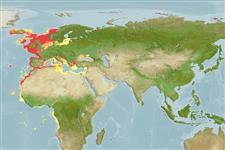>
Carangiformes (Jacks) >
Carangidae (Jacks and pompanos) > Caranginae
Etymology: Trachurus: Greek, trachys, -eia, -ys = rough + Greek, oura = tail (Ref. 45335).
More on author: Linnaeus.
Environment: milieu / climate zone / depth range / distribution range
पारिस्थितिकी
समुद्री; औशिनोड़िरोमस (Ref. 51243); गहराई सीमा 0 - 1050 m (Ref. 54256), usually 100 - 200 m (Ref. 54256). Subtropical; 67°N - 38°S, 26°W - 42°E
Eastern Atlantic: from Madeira, the Straits of Gibraltar and Canary and Cape Verde Islands to South Africa; northward extending into the Mediterranean Sea and along the Atlantic coasts of Europe to Norway.
Length at first maturity / आकार / वज़न / Age
Maturity: Lm 22.9, range 21 - 30 cm
Max length : 70.0 cm TL पुल्लिंग / अलिंग; (Ref. 3197); common length : 22.0 cm FL पुल्लिंग / अलिंग; (Ref. 3397); अधिकतम प्रकाशित वज़न: 2.0 kg (Ref. 27584)
पृष्ठीय रीढ़ (सम्पूर्ण) : 9; पृष्ठीय सौफट रेज़ (सम्पूर्ण) : 30 - 36; गुदा कांटा: 3; ऐनल सौफट रेज़: 24 - 32. Bluish green, grey or black above, silvery white below; opercle with black spot (Ref. 3197). Lateral scales tall and keeled. Gill cover with a distinct black spot. First dorsal fin tall (Ref. 35388).
Adults form large schools in coastal areas with sandy substrate. They feed on fish, crustaceans, and cephalopods. Are batch spawners (Ref. 51846). Females lay 140,000 eggs, which hatch into 5mm long larvae (Ref. 35388). Eggs are pelagic (Ref. 4233). Utilized fresh, smoked, canned and frozen; can be fried, broiled and baked (Ref. 9988). Divided into two stocks: West stock and North Sea stock. West stock spawns in a belt from the Biscay to Ireland in early spring, migrates north and eastwards to southern Norway and northern North Sea. North Sea stock spawns in the southern North Sea in summer, migrates to central North Sea, Skagerrak and Kattegat.
Smith-Vaniz, W.F., 1986. Carangidae. p. 815-844. In P.J.P. Whitehead, M.-L. Bauchot, J.-C. Hureau, J. Nielsen and E. Tortonese (eds.) Fishes of the north-eastern Atlantic and the Mediterranean. UNESCO, Paris. vol. 2. (Ref. 4233)
IUCN Red List Status (Ref. 130435: Version 2024-2)
Threat to humans
Harmless
Human uses
मात्स्यिकी: उच्च वाणिज्य; आखेट मत्स्य: हां; ठहराव / प्रलोभन: usually
साधन
Special reports
Download XML
इंटरनेट स्रोत
Estimates based on models
Preferred temperature (Ref.
123201): 10.6 - 16.6, mean 13.3 °C (based on 165 cells).
Phylogenetic diversity index (Ref.
82804): PD
50 = 0.5001 [Uniqueness, from 0.5 = low to 2.0 = high].
Bayesian length-weight: a=0.00813 (0.00745 - 0.00887), b=2.96 (2.94 - 2.98), in cm total length, based on LWR estimates for this species (Ref.
93245).
Trophic level (Ref.
69278): 3.7 ±0.0 se; based on diet studies.
Generation time: 6.5 (5.1 - 7.6) years. Estimated as median ln(3)/K based on 25
growth studies.
लौटाव (Ref.
120179): माध्यम, न्यूनतम जनसंख्या दुगनी होने का समय 1.4 - 4.4 वर्ष। (K=0.12-0.16; tm=2-4; tmax=11; Fec=70,000).
Prior r = 0.39, 95% CL = 0.26 - 0.58, Based on 13 full stock assessments.
Fishing Vulnerability (Ref.
59153): High vulnerability (56 of 100).
Climate Vulnerability (Ref.
125649): Low vulnerability (25 of 100).
Nutrients (Ref.
124155): Calcium = 184 [129, 263] mg/100g; Iron = 3.67 [2.45, 5.60] mg/100g; Protein = 19.4 [18.8, 20.0] %; Omega3 = 0.355 [0.260, 0.479] g/100g; Selenium = 33.4 [24.6, 45.6] μg/100g; VitaminA = 13.5 [4.0, 54.4] μg/100g; Zinc = 1.66 [1.34, 2.16] mg/100g (wet weight); based on
nutrient studies.
